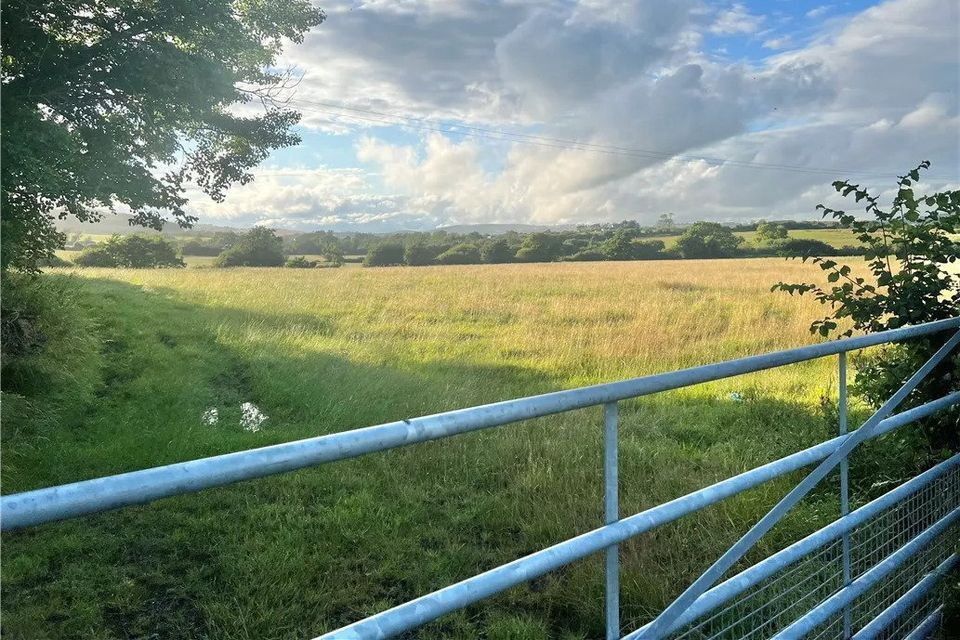Wicklow agricultural land prices up to 29 per cent higher than 2023 national average
A 46-acre plot of agricultural land in Ballymoyle, Arklow, sold for more than €15,000 per acre at auction last September.
A market review report by the Society of Chartered Surveyors Ireland (SCSI) and Teagasc has shown that average agricultural land prices in Wicklow were up to 29 per cent higher than the national average last year.
SCSI/Teagasc’s Agricultural Land Market Review and Outlook Report found that, on non-residential farmland holdings under 50 acres, Wicklow prices ranged from €8,167 per acre for poor land (up from €7,375 in 2022) to €14,833 for good land in 2023, with the national average value of good quality land €12,308 per acre and €6,286 for poor quality land during the same period.
On holdings under 50 acres, Wicklow had the sixth most expensive good quality land in Leinster last year, up from €13,875 in 2022 (7pc increase), with higher land values recorded in Kildare (€16,400), Meath (€16,225), Carlow (€15,750), Kilkenny (€15,333) and Wexford (€15,200).
Garden County land prices showed some minor deviation on properties between 50 and 100 acres, €5,750 per acre for poor land to €14,333 for good, and over 100 acres, €6,833 per acre for poor land to €14,000 for good.
SCSI auctioneers and valuers are forecasting that the price of agricultural land nationally will increase by 6pc on average this year, mainly due to an expected recovery in milk prices and continuing strong demand from farmers and investors.
Auctioneer and valuer members of the SCSI operating in the agricultural sales and rental market say average rental prices in 2024 are expected to increase by 4pc.
In contrast, SCSI agents expect average land rental prices in Leinster to decrease by 1pc this year. In Leinster (excluding Dublin), rental values decreased by 2pc last year, following a 9pc increase in 2022, with prices ranging from €249 for grazing only to €429 for potatoes.
While price increases will continue to be driven by high demand and low supply, SCSI auctioneers and valuers say the rate of increase is moderating due to several factors, including higher interest rates, poor weather conditions and lower farming returns.
Teagasc is warning that the impact of the adverse weather on agricultural output, production costs and farm incomes is a concern and presents an area of uncertainty for the current production year.
Auctioneer David Quinn of Quinn Property Carnew said that while demand for land - primarily by dairy farmers - had continued to drive land sales and rental price increases last year, price expectations for 2024 have moderated due to several factors.
“We can see this most readily in the rental market, which reacts more quickly to economic changes in farming,” Mr Quinn said.
“Last year, average rental values increased by just 4.5pc across all farming uses despite predictions of double-digit growth similar to that which occurred in 2022.
“These increases did not materialise due in the main to poorer overall returns in farming and very poor weather conditions, which dampened demand from some farming sectors – particularly in Leinster and Connacht/Ulster – and kept a lid on rental inflation.
“Last year was a very poor one for tillage farmers, and with the very poor weather continuing well into 2024, auctioneers and valuers are forecasting a modest average national increase in rental values of just 4pc this year, ranging from a 7pc increase in Munster to a decrease of 1pc in Leinster.
“While land values are expected to increase again this year, mainly due to an expected improvement in milk prices and strong interest from farmers and investors, the increases are forecast to be an average of 6pc, well down on the double-digit growth recorded last year.
“On a provincial level Leinster, Munster and Connacht/Ulster are projected to experience an increase of land values by 4pc, 11pc and 5pc respectively.
“Last year, over a third of respondents to our survey expected a significant increase in dairy farmers buying land, now 12 months on, that figure has fallen to just 3pc of respondents,” he added.
“In addition to the lower milk prices we saw last year, one of the other factors which SCSI auctioneers and valuers referenced was the impact of higher interest rates, particularly on smaller farms that came to the market as buyers are more likely to avail of borrowed funds for these types of holdings in contrast to those purchasing large farms.”


